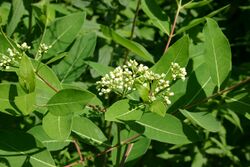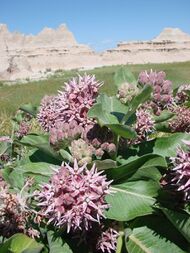Biology:List of Gentianales of Montana
From HandWiki
Revision as of 09:16, 7 August 2021 by imported>Corlink (correction)
There are at least 28 members of the dogbane, gentian and milkweed order, Gentianales, found in Montana.[1] Some of these species are exotics (not native to Montana)[2] and some species have been designated as Species of Concern.[3]
Dogbanes
Family: Apocynaceae
- Apocynum androsaemifolium, spreading dogbane
- Apocynum cannabinum, clasping-leaf dogbane
Gentians
Family: Gentianaceae
- Centaurium exaltatum, western centaury
- Eustoma grandiflorum, showy prairie-gentian
- Frasera albicaulis, white-stem frasera
- Frasera speciosa, green gentian
- Gentiana affinis, prairie gentian
- Gentiana algida, whitish gentian
- Gentiana calycosa, explorer's gentian
- Gentiana fremontii, moss gentian
- Gentiana glauca, glaucous gentian
- Gentiana prostrata, pygmy gentian
- Gentianella amarella, northern gentian
- Gentianella propinqua, four-parted gentian
- Gentianella tenella, slender gentian
- Gentianopsis macounii, Macoun's gentian
- Gentianopsis simplex, hiker's gentian
- Gentianopsis thermalis, Rocky Mountain fringed gentian
- Halenia deflexa, spurred gentian
- Lomatogonium rotatum, marsh felwort
- Swertia perennis, felwort
Milkweeds
Family: Asclepiadaceae
- Asclepias incarnata, swamp milkweed
- Asclepias ovalifolia, ovalleaf milkweed
- Asclepias pumila, low milkweed
- Asclepias speciosa, showy milkweed
- Asclepias stenophylla, narrowleaf milkweed
- Asclepias verticillata, whorled milkweed
- Asclepias viridiflora, green milkweed
Further reading
- Schiemann, Donald Anthony (2005). Wildflowers of Montana. Missoula, MT: Mountain Press Publishing. ISBN 0-87842-504-7.
See also
Notes
- ↑ "Dogbane, Gentian and Milkweed". Montana Natural Heritage Project. http://fieldguide.mt.gov/displayFamily.aspx?order=Gentianales. Retrieved 2011-06-17.
- ↑ Exotic species have been deliberately or accidentally introduced to areas outside of their native geographic range and are able to reproduce and maintain sustainable populations in these areas. These exotic populations may also be referred to as alien, introduced, invasive, non-native, or non-indigenous. "Species Status Codes, Exotics". Montana Natural Heritage Project. http://fieldguide.mt.gov/statusCodes.aspx#exotic. Retrieved 2011-06-17.
- ↑ Species of Concern are native taxa that are at-risk due to declining population trends, threats to their habitats, restricted distribution, and/or other factors. Designation as a Montana Species of Concern or Species of Concern is based on the Montana Status Rank, and is not a statutory or regulatory classification. Rather, these designations provide information that helps resource managers make proactive decisions regarding species conservation and data collection priorities. "Species Status Codes, Species of Concern". Montana Natural Heritage Project. http://fieldguide.mt.gov/statusCodes.aspx#soc. Retrieved 2011-06-17.
 |




